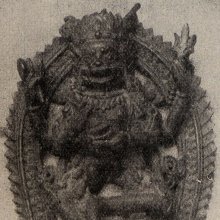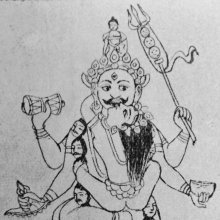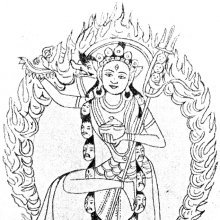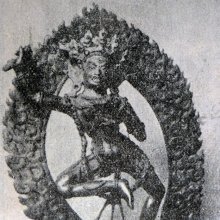Rupini, Rūpinī, Rūpiṇī: 11 definitions
Introduction:
Rupini means something in Buddhism, Pali, Hinduism, Sanskrit. If you want to know the exact meaning, history, etymology or English translation of this term then check out the descriptions on this page. Add your comment or reference to a book if you want to contribute to this summary article.
Images (photo gallery)
In Hinduism
Purana and Itihasa (epic history)
Source: Cologne Digital Sanskrit Dictionaries: The Purana IndexRūpiṇī (रूपिणी).—A Varṇa śakti.*
- * Brahmāṇḍa-purāṇa IV. 44. 59 and 118.

The Purana (पुराण, purāṇas) refers to Sanskrit literature preserving ancient India’s vast cultural history, including historical legends, religious ceremonies, various arts and sciences. The eighteen mahapuranas total over 400,000 shlokas (metrical couplets) and date to at least several centuries BCE.
Shaivism (Shaiva philosophy)
Source: archive.org: Indian Historical Quarterly Vol. 7 (shaivism)Rūpinī (रूपिनी) refers to one of the twenty-four names of the Lāmās, according to the 8th-centry Jayadratha-yāmala.—While describing the special practices of the Lāmās mentions the special language to be used with them. This language is described as monosyllabic (ekākṣara-samullāpa) and may thus be considered to have belonged to the Sino-Tibetan family as the Lamas themselves belonged to the Tibetan group of mystics. The Lāmās [viz., Rūpinī], according to this language, had 24 different names.

Shaiva (शैव, śaiva) or Shaivism (śaivism) represents a tradition of Hinduism worshiping Shiva as the supreme being. Closely related to Shaktism, Shaiva literature includes a range of scriptures, including Tantras, while the root of this tradition may be traced back to the ancient Vedas.
In Buddhism
Tibetan Buddhism (Vajrayana or tantric Buddhism)
Source: Wisdom Library: Tibetan Buddhism1) Rūpiṇī (रूपिणी) is the name of Dūtī (i.e., messengers of Lord Vajrapāṇi) mentioned as attending the teachings in the 6th century Mañjuśrīmūlakalpa: one of the largest Kriyā Tantras devoted to Mañjuśrī (the Bodhisattva of wisdom) representing an encyclopedia of knowledge primarily concerned with ritualistic elements in Buddhism. The teachings in this text originate from Mañjuśrī and were taught to and by Buddha Śākyamuni in the presence of a large audience (including Rūpiṇī).
2) Rūpiṇī (रूपिणी) also refers to a group of deities summoned by the Yamāntaka-mantra and mentioned as attending the teachings in the 6th century Mañjuśrīmūlakalpa.
Source: archive.org: The Indian Buddhist Iconography1) Rūpiṇī (रूपिणी) refers to one of the four Ḍākinī Goddesses, as mentioned in the 5th-century Sādhanamālā (a collection of sādhana texts that contain detailed instructions for rituals).—In this group of Goddesses are included the names of [viz., Rupiṇī] who are widely mentioned in the Tantric works of rituals. In the sambara-maṇḍala of the Niṣpannayogāvalī their names are mentioned as companion deities of Sambara. Again, in the ṣaṭcakravarti-maṇḍala they are mentioned as companion deities. But their forms are found described only in the Sādhanamālā. According to this authority they [viz., Rupiṇī] are all alike in appearance holding identical symbols.
2) Rūpiṇī (रूपिणी) is one of the twenty-four Goddesses surrounding Buddhakapāla in the buddhakapālamaṇḍala, according to the same Sādhanamālā.—Buddhakapāla refers to one of the various emanations of Akṣobhya and the sādhana says that when Heruka is embraced by Citrasenā he gets the name of Buddhakapāla.—Rūpiṇī stands in the north of the middle circle. She has a blue colour two arms, one face, ornaments of bones, brown hair rising upwards but no garlands of heads. She carries the kapāla in the left and the kartri in the right, and dances in the ardhaparyaṅka attitude.
Source: Wisdomlib Libary: VajrayoginiRūpiṇī (रूपिणी, “horse-faced”) is the name of the goddess found on the southern petal of the vārāhyabhyudaya-maṇḍala, according to the Vārāhyabhyudayatantra (largerly extracted from the 10th century Abhidhānottaratantra). The central deity of the vārāhyabhyudaya-maṇḍala is the twelve-armed Vajravarāhī, which is modeled upon the twelve-armed Cakrasaṃvara, thus inhibiting many similar iconographical features.
Rūpiṇī is to be visualised by the practitioner as a fierce and therianthropic (half-beast, half-human) goddess having three eyes, loose hair and dancing naked in the ardhaparyaṅka pose, with Bhairava and Kālarāri beneath their feet. They are depicted as having four arms, holding a skull and staff in two arms while holding the head of Brahmā and a chopper in the other two arms.
Source: academia.edu: The Structure and Meanings of the Heruka MaṇḍalaRūpiṇī (रूपिणी) refers to one of the twenty-four Ḍākinīs positioned at the padma (lotus) in the middle of the Herukamaṇḍala, according to the 10th century Ḍākārṇava chapter 15. Accordingly, between the south and east (of the heruka-maṇḍala) are six Ḍākinīs who are half yellow and half black in color. They [viz., Rūpiṇī] are headed by the major four Ḍākinīs of the Cakrasaṃvara tradition. They stand in the Pratyālīḍha posture and, except for the body posture, their physical features and objects that they hold are the same as Vajravārāhīs.
Rūpiṇī (रूपिणी) is also mentioned as the Ḍākinī who, together with the Vīra (hero) named Ratnaḍāka forms one of the 36 pairs situated in the Vajracakra. Accordingly, the vajracakra refers to one of the four divisions of the sahaja-puṭa (‘innate layer’), situated within the padma (lotus) in the middle of the Herukamaṇḍala. The 36 pairs of Ḍākinīs [viz., Rūpiṇī] and Vīras each have one face and four arms; they hold a skull bowl, a skull staff, a small drum and a knife; they are dark-bluish-black in color.
Source: OSU Press: Cakrasamvara SamadhiRūpiṇī (रूपिणी) (yellow) refers to one of the four essence Yoginīs of the Saṃvaramaṇḍala of Abhayākaragupta’s Niṣpannayogāvalī, p. 45 and n. 145; (Cf. Cakrasaṃvaratantra, Gray, David B., 2007).—The Cakrasaṃvara-maṇḍala has a total of sixty-two deities. [...] The four essence Yoginīs, Ḍākinī (blue), Lāmā (green), Khanḍarohā (red), and Rūpiṇī (yellow), in counter-clockwise order, east, north, west, and south, in the primary directions.—Rūpiṇī is associated with the Bodhipakṣa of citta-smṛtyupasthāna (“mindfulness of thoughts”).

Tibetan Buddhism includes schools such as Nyingma, Kadampa, Kagyu and Gelug. Their primary canon of literature is divided in two broad categories: The Kangyur, which consists of Buddha’s words, and the Tengyur, which includes commentaries from various sources. Esotericism and tantra techniques (vajrayāna) are collected indepently.
Languages of India and abroad
Pali-English dictionary
Source: BuddhaSasana: Concise Pali-English Dictionaryrūpinī : (f.) a beautiful woman.

Pali is the language of the Tipiṭaka, which is the sacred canon of Theravāda Buddhism and contains much of the Buddha’s speech. Closeley related to Sanskrit, both languages are used interchangeably between religions.
Sanskrit dictionary
Source: Cologne Digital Sanskrit Dictionaries: Edgerton Buddhist Hybrid Sanskrit DictionaryRūpiṇī (रूपिणी).—a kind of malevolent superhuman being: (Ārya-)Mañjuśrīmūlakalpa 17.8, pl. °ṇyo (also mahā-r°); name of a yoginī or similar demoness, Sādhanamālā 425.13, 439.10; name of a ‘goddess’ (the same?) Sādhanamālā 502.7.
Sanskrit, also spelled संस्कृतम् (saṃskṛtam), is an ancient language of India commonly seen as the grandmother of the Indo-European language family (even English!). Closely allied with Prakrit and Pali, Sanskrit is more exhaustive in both grammar and terms and has the most extensive collection of literature in the world, greatly surpassing its sister-languages Greek and Latin.
Kannada-English dictionary
Source: Alar: Kannada-English corpusRūpiṇi (ರೂಪಿಣಿ):—
1) [noun] = ರೂಪವತಿ [rupavati].
2) [noun] a lascivious woman; a prostitute.
Kannada is a Dravidian language (as opposed to the Indo-European language family) mainly spoken in the southwestern region of India.
Nepali dictionary
Source: unoes: Nepali-English DictionaryRūpiṇī (रूपिणी):—adj. beautiful; charming; attractive; appealing;
Nepali is the primary language of the Nepalese people counting almost 20 million native speakers. The country of Nepal is situated in the Himalaya mountain range to the north of India.
See also (Relevant definitions)
Starts with: Rupinika.
Ends with (+47): Adbhutarupini, Adivyasvarupini, Aikyasvarupini, Amritarupini, Amsharupini, Anandarupini, Bahurupin, Bhagarupini, Bindurupini, Bodharupini, Brahmarupini, Buddhirupini, Cararupini, Carurupini, Chararupini, Chitrarupini, Citrarupini, Divyadivyasvarupini, Divyasvarupini, Gunarupini.
Full-text (+19): Rupinika, Rupi, Vishvarupini, Shrikriyarupini, Lama, Kalarupini, Mrityurupini, Maharupini, Kalamsharupini, Vishvarupi, Kamarupini, Amsharupini, Brahmarupini, Mrityurupin, Kalamsha, Sahajanandarupi, Citsukha, Dakini, Khandaroha, Ratnadaka.
Relevant text
Search found 22 books and stories containing Rupini, Rūpinī, Rūpiṇī, Rūpiṇi, Roopini; (plurals include: Rupinis, Rūpinīs, Rūpiṇīs, Rūpiṇis, Roopinis). You can also click to the full overview containing English textual excerpts. Below are direct links for the most relevant articles:
Garga Samhita (English) (by Danavir Goswami)
Verse 4.19.67 < [Chapter 19 - A Thousand Names of Srī Yamunā]
Verse 4.19.4 < [Chapter 19 - A Thousand Names of Srī Yamunā]
Verse 4.19.95 < [Chapter 19 - A Thousand Names of Srī Yamunā]
Cidgaganacandrika (study) (by S. Mahalakshmi)
Verse 10 [The inseparable form of Śiva-Śakti] < [Chapter 1 - First Vimarśa]
Bhakti-rasamrta-sindhu (by Śrīla Rūpa Gosvāmī)
Verse 2.1.246 < [Part 1 - Ecstatic Excitants (vibhāva)]
The Indian Buddhist Iconography (by Benoytosh Bhattachacharyya)
Figure 126-127 - Emanations of Akṣobhya: Buddhakapāla
Chaitanya Bhagavata (by Bhumipati Dāsa)
Verse 2.5.122 < [Chapter 5 - Lord Nityānanda’s Vyāsa-pūjā Ceremony and His Darśana of the Lord’s Six-armed Form]



